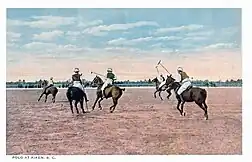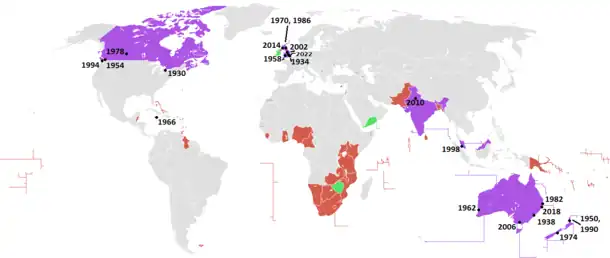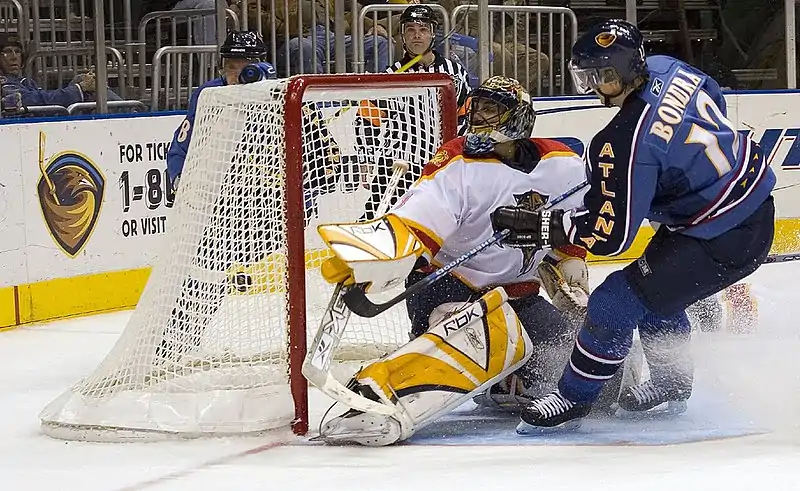Western sports
Western sports are sports that are strongly associated with the West.[lower-alpha 1] Many modern sports were invented in or standardized by Western countries;[1] in particular, many major sports were invented in the United Kingdom after the Industrial Revolution,[2][3] and later, America invented some major sports such as basketball and baseball.[4]

Western European colonialism and American influence were the initial causes of the spread of Western sports around the world.[5] Later, globalization and the prominent role of Western sports in the Olympic Games helped further grow Western sports.[1][6][7] The most-watched international sporting event is the FIFA World Cup, which showcases the Western sport of football (also known as soccer).[8]
History
Various minor games and board games were transmitted between the West and the rest of the world in antiquity. Chess originated in India as chaturanga.[9]
Antiquity
The Romans built immense structures such as the amphitheatres to house their festivals of sport. The Romans exhibited a passion for blood sports, such as the infamous Gladiatorial battles that pitted contestants against one another in a fight to the death. The Olympic Games revived many of the sports of classical antiquity—such as Greco-Roman wrestling, discus and javelin.[10] The sport of bullfighting is a traditional spectacle of Spain, Portugal, southern France, and some Latin American countries. It traces its roots to prehistoric bull worship and sacrifice and is often linked to Rome, where many human-versus-animal events were held. Bullfighting spread from Spain to its American colonies, and in the 19th century to France, where it developed into a distinctive form in its own right.[11]
Middle Ages
Jousting and hunting were popular sports in the European Middle Ages, and the aristocratic classes developed passions for leisure activities. A great number of popular global sports were first developed or codified in Europe. The modern game of golf originated in Scotland, where the first written record of golf is James II's banning of the game in 1457, as an unwelcome distraction to learning archery.[12]
Colonial era

Western European countries used sport as a method to increase cultural connections between themselves and their colonies. Colonizers also used sport as a way to keep their soldiers fit in tough environments and to create social changes among colonized peoples; the philosophy of Muscular Christianity was influential in this regard in British colonies, and was also put in practice in Asia by the YMCA.[13] This had an intended effect of causing the decline of traditional sports around the world.[14][15][16] On the other hand, colonized peoples often used Western sports as an opportunity to prove themselves by defeating their colonizers in said sports; this contributed to many nascent independence movements.[17]
In South Asia, the influence of and resistance to Western sport also led to the standardization of some traditional Indian games such as kabaddi and introduced organized competitions at statewide and national levels for these games.[18][19][20] In China, the introduction of Western sports resulted in sports being valued more in terms of their competitive aspects,[21][22] in contrast to a native emphasis on sports being used for harmony between people and nature.[23][24][25] In Japan, Western sports were adopted as part of the Meiji era modernization, and were given values in line with the samurai philosophy of Bushido.[26]
Some sports were imported to the West from its colonies; for example, the equestrian game of polo, which was discovered by the British in South Asia, was spread by the British worldwide in a British-standardized form.[27][28] The British also modified some Indian board games to create the modern games of snakes and ladders and ludo.[29]
British sports
The Industrial Revolution that began in Great Britain in the 18th century brought increased leisure time, leading to more opportunities for citizens to participate in athletic activities and also follow spectator sports. These trends continued with the advent of mass media and global communication. The bat and ball sport of cricket was first played in England during the 16th century and was exported around the globe via the British Empire. A number of popular modern sports were devised or codified in the United Kingdom during the 19th century and obtained global prominence; these include ping pong, modern tennis, association football, netball and rugby.[30]
The British sought to use their sports as a method to propagate their moral values among their colonial subjects, and to prove the superiority of British culture.[31][32]
American sports
The United States also developed unique variations of English sports. English migrants took antecedents of baseball to America during the colonial period. The history of American football can be traced to early versions of rugby football and association football.[33] Many games are known as "football" were being played at colleges and universities in the United States in the first half of the 19th century. American football resulted from several major divergences from rugby, most notably the rule changes instituted by Walter Camp, the "Father of American football".[34] Basketball was invented in 1891 by James Naismith, a Canadian physical education instructor working in Springfield, Massachusetts, in the United States.[35] Volleyball was created in Holyoke, Massachusetts, a city directly north of Springfield, in 1895.[36] In the case of lacrosse, a Native American sport became a professional American sport.[37][38]
The United States pioneered the professionalization of sports; leagues like Major League Baseball, National Football League, and the National Basketball Association are still among the wealthiest leagues in the world.[39][40]
America introduced some of its sports to various Asian countries (including American colonies in Asia); this resulted in baseball becoming established in Japan and basketball becoming popular in China.[41] Japanese colonization of East Asia helped to spread baseball and other Western sports in the region.[42][43]
Post-colonial era

Even as European colonization of the world came to an end after World War 2, Western sports continued to play a prominent role. Western sports became an important part of nation-building and diplomacy for some newly independent countries;[44] for example, cricket played a significant role in helping India unite its diverse peoples and conduct diplomacy when it faced tensions with its neighbor Pakistan.[45][46] With the advent of T20 cricket, a greatly shortened version of the game, cricket leagues have become prominent in South Asia and beyond, with the Indian Premier League now among the richest sports leagues in the world.[47] Western sports also play an important role in the promotion of health and good societal values (such as gender equality) in former colonies,[48] and are generally seen as an important part of the modernization process.[21] The worldwide dominance of Western sports has also resulted in competitions based in Western countries overtaking the popularity of local competitions in other parts of the world,[49] and the further decline of non-Western sports.[50][51][52] Western sports have also grown because of their economic dominance and brand identification among fans.[53]
The Olympic Games, though they initially started off with an emphasis on including traditional games from around the world,[54] eventually became a major transmission vector for Western sports, with Western nations dominating in the event. However, some non-Western sports such as judo have over time become part of the Olympics.[55]
E-sports have emerged in the modern era; video game adaptations of Western sports have also become popular, such as the FIFA video game series.[56]
Some traditional Western games have been adapted into major professional competitions, as is the case with World Chase Tag for the game of tag.[57]
Major multi-sport events

Olympic Games
The modern Olympic Games or Olympics (French: Jeux olympiques)[lower-alpha 2][58] are the leading international sporting events featuring summer and winter sports competitions in which thousands of athletes from around the world participate in a variety of competitions. The Olympic Games are considered the world's foremost sports competition with more than 200 teams, representing sovereign states and territories participating; by default the Games generally substitute for any World Championships the year in which they take place (however, each class usually maintains their own records).[59] The Olympic Games are normally held every four years, and since 1994, have alternated between the Summer and Winter Olympics every two years during the four-year period.
Their creation was inspired by the ancient Olympic Games (Ancient Greek: Ὀλυμπιακοί Ἀγῶνες), held in Olympia, Greece from the 8th century BC to the 4th century AD. Baron Pierre de Coubertin founded the International Olympic Committee (IOC) in 1894, leading to the first modern Games in Athens in 1896. The IOC is the governing body of the Olympic Movement (which encompasses all entities and individuals involved in the Olympic Games) with the Olympic Charter defining its structure and authority.Commonwealth Games

List of sports
Athletics
Bat-and ball games

Baseball
Cricket
Goal sports

Basketball
Football
Hockey
Golf
Racket sports
References
- "Beijing 2008 Olympic Games - Globalization, Sports Processes | Britannica". www.britannica.com. Retrieved 2023-10-03.
- Clarey, Christopher (2012-07-26). "Britain's Living Legacy to the Games: Sports". The New York Times. ISSN 0362-4331. Retrieved 2023-10-03.
- Vamplew, Wray (2016-03-15). "Sport, industry and industrial sport in Britain before 1914: review and revision". Sport in Society. 19 (3): 340–355. doi:10.1080/17430437.2015.1057942. ISSN 1743-0437. S2CID 145543051.
- Giaimo, Cara (2016-08-26). "The Surprising Massachusetts Origins of Nearly Every American Sport". Atlas Obscura. Retrieved 2023-10-03.
- Cleophas, Francois (2021-08-24). "How colonial history shaped bodies and sport at the edges of empire". The Conversation. Retrieved 2023-10-03.
- Lee, Byung Jin; Kim, Tae Young (2016-02-23). "A study on the birth and globalization of sports originated from each continent". Journal of Exercise Rehabilitation. 12 (1): 2–9. doi:10.12965/jer.150248. ISSN 2288-176X. PMC 4771148. PMID 26933653.
- Manzenreiter, Wolfram (2010-03-22). "Global movements, sports spectacles and the transformation of representational power". Asia Pacific World. 1 (1): 37–56. doi:10.3167/apw.2010010104 (inactive 2023-10-03).
{{cite journal}}: CS1 maint: DOI inactive as of October 2023 (link) - Stacker, Sam Kaye (2022-11-17). "The World Cup is the most-watched sporting event internationally. Here's how it stacks up to US events". Fredericksburg.com. Retrieved 2023-10-03.
- "Shah Mat! The Global Origins of Chess in War and Diplomacy". History Hit. Retrieved 2023-10-03.
- The Allure of Sports in Western Culture. University of Toronto Press. 2019. doi:10.3138/j.ctvpmw44f. ISBN 978-1-4875-0418-2.
- Barbara Schrodt, "Sports of the Byzantine empire." Journal of Sport History 8.3 (1981): 40-59.
- Sall E. D. Wilkins, Sports and games of medieval cultures (Greenwood, 2002).
- McComb, David G. (2004). Sports in World History. Psychology Press. ISBN 978-0-415-31812-9.
- Leng, Ho Keat; Pyun, Do Young; Lin, Yen-Chun (2023-07-14). "Special issue: sports and leisure management in Asia". Managing Sport and Leisure: 1–3. doi:10.1080/23750472.2023.2207865. ISSN 2375-0472. S2CID 259909018.
- Vaczi, Mariann; Bairner, Alan (2023-10-06). Indigenous, Traditional, and Folk Sports: Contesting Modernities. Taylor & Francis. ISBN 978-1-000-98328-9.
- Karen, David; Washington, Robert E. (2015-03-02). Sociological Perspectives on Sport: The Games Outside the Games. Routledge. ISBN 978-1-317-97394-2.
- JaMichael (2023-04-14). "The Role of Sports in Colonialism and Decolonization". Beyond Sports. Retrieved 2023-10-03.
- Bromber, Katrin; Krawietz, Birgit; Maguire, Joseph (2013). Sport Across Asia: Politics, Cultures, and Identities. Routledge. ISBN 978-0-415-88438-9.
- Love, Adam; Dzikus, Lars (2020-02-26). "How India came to love cricket, favored sport of its colonial British rulers". The Conversation. Retrieved 2023-10-04.
- FISCHER-TINÉ, HARALD (2018-09-25). "Fitness for Modernity? The YMCA and physical-education schemes in late-colonial South Asia (circa1900–40)". Modern Asian Studies. 53 (2): 512–559. doi:10.1017/s0026749x17000300. ISSN 0026-749X.
- Hong, Fan; Li, Liu (2023-06-30). Routledge Handbook of Sport in China. Taylor & Francis. ISBN 978-1-000-90082-8.
- Duan, Huiqiao (2016). "Comparison analysis of Chinese and western leisure sports culture". Atlantis Press. doi:10.2991/msetasse-16.2016.29. ISBN 978-94-6252-263-3.
{{cite journal}}: Cite journal requires|journal=(help) - Wang*, Sc (2019-07-23). "Analysis of the characteristics of chinese traditional sports culture in the new period". Journal of Sports Medicine and Therapy. 4 (3): 053–060. doi:10.29328/journal.jsmt.1001044.
- Pan, Huei-Wen; Huang, Wei-Yang (2019-02-25). The Collision, Impact, Integration and Globalization of Eastern and Western Sports Culture (Report). doi:10.31124/advance.7762787.v1.
- Chunlei, Lu (2011). "How China plays the game: a cultural perspective on sports in China".
{{cite journal}}: Cite journal requires|journal=(help) - "This sporting life : sports and body culture in modern Japan". www.semanticscholar.org. Retrieved 2023-10-26.
- Sen, Ronojoy (2015-10-27). Nation at Play: A History of Sport in India. Columbia University Press. ISBN 978-0-231-53993-7.
- "The Army's impact on sport | National Army Museum". www.nam.ac.uk. Retrieved 2023-10-03.
- "Reviving traditional games of India". The Hindu. 2012-06-10. ISSN 0971-751X. Retrieved 2023-10-03.
- Tranter, N. L. "Popular sports and the industrial revolution in Scotland: the evidence of the statistical accounts." International Journal of the History of Sport 4.1 (1987): 21-38.
- Subba, Awashes (2022-10-20), "Popularizing Western Sports in Darjeeling Hills: The Context of Educational Institutions", Darjeeling (1 ed.), London: Routledge, pp. 89–98, doi:10.4324/9781003362791-8, ISBN 978-1-003-36279-1, retrieved 2023-10-26
- "The willow and the palm : an exploration of the role of cricket in Fiji". ResearchGate.
- "Popular Culture: from Baseball to Rock and Roll - John Bull and Uncle Sam: Four Centuries of British-American Relations | Exhibitions (Library of Congress)". www.loc.gov. 2010-07-22. Retrieved 2023-10-03.
- Collins, Tony (2013). "Unexceptional exceptionalism: the origins of American football in a transnational context". Journal of Global History. 8 (2): 209–230. doi:10.1017/S1740022813000193. ISSN 1740-0228. S2CID 162414097.
- "Here's the history of basketball—from peach baskets in Springfield to global phenomenon". History. 2021-03-27. Retrieved 2023-10-03.
- MarjoMarjo (2023-09-26). "17 Life-Changing Inventions You Didn't Know Were From Massachusetts". Live 95.9. Retrieved 2023-10-03.
- "The Native American Origins of Lacrosse". HISTORY. 2023-07-12. Retrieved 2023-10-03.
- Delsahut, Fabrice; Terret, Thierry (2014-11-02). "First Nations Women, Games, and Sport in Pre- and Post-Colonial North America". Women's History Review. 23 (6): 976–995. doi:10.1080/09612025.2014.945801. ISSN 0961-2025. S2CID 143904665.
- "A Brief History and the Evolution of Sports in the United States". Brewminate: A Bold Blend of News and Ideas. 2022-07-28. Retrieved 2023-10-03.
- Riess, Steven A. (2017-02-27), "Professional Team Sports in the United States", Oxford Research Encyclopedia of American History, doi:10.1093/acrefore/9780199329175.001.0001/acrefore-9780199329175-e-198, ISBN 978-0-19-932917-5, retrieved 2023-10-03
- "How Basketball Became China's Most Beloved Sport — RADII". Stories from the center of China’s youth culture. Retrieved 2023-10-03.
- Morris, Andrew D. (2011). Colonial Project, National Game: A History of Baseball in Taiwan (1 ed.). University of California Press. ISBN 978-0-520-26279-9. JSTOR 10.1525/j.ctt1pnhhp.
- Hargrove, Sarah A. (2007). Baseball and Politics in East Asia (Thesis thesis).
- Darnell, Simon C.; Field, Russell; Kidd, Bruce (2019), Darnell, Simon C.; Field, Russell; Kidd, Bruce (eds.), "Anti-Colonialism and the Decolonization of Sport Development", The History and Politics of Sport-for-Development: Activists, Ideologues and Reformers, Global Culture and Sport Series, London: Palgrave Macmillan UK, pp. 125–159, doi:10.1057/978-1-137-43944-4_5, ISBN 978-1-137-43944-4, S2CID 159173362, retrieved 2023-10-03
- "How cricket bats for democracy in India". South China Morning Post. 2017-12-30. Retrieved 2023-10-03.
- "India and Pakistan's Cricket Diplomacy". thediplomat.com. Retrieved 2023-10-03.
- Aripaka, Rahul (2023-04-30). "IPL: How India became home to the biggest, baddest cricketing league in the world". The Economic Times. ISSN 0013-0389. Retrieved 2023-10-03.
- Riordan, Jim (1986). "State and Sport in Developing Societies". International Review for the Sociology of Sport. 21 (4): 287–303. doi:10.1177/101269028602100403. ISSN 1012-6902.
- Rowe, David; Gilmour, Callum (2010). "Sport, Media, and Consumption in Asia: A Merchandised Milieu". American Behavioral Scientist. 53 (10): 1530–1548. doi:10.1177/0002764210368083. ISSN 0002-7642.
- "Endangered Species of the Physical Cultural Landscape: Globalization, Nationalism, and Safeguarding Traditional Folk Games". scholar.google.ca. Retrieved 2023-10-26.
- Gilmour, Callum; Rowe, David (2012-12-01). "Sport in Malaysia: National Imperatives and Western Seductions". Sociology of Sport Journal. 29 (4): 485–505. doi:10.1123/ssj.29.4.485. ISSN 0741-1235.
- Shehu, Jimoh (2004). "Sport for all in postcolony: Is there a place for indigenous games in physical education curriculum and research in Africa". Africa Education Review. 1 (1): 21–33. doi:10.1080/18146620408566267. ISSN 1814-6627.
- Xu, Ye (2016-08-23). "The Formation of Global Sports Fandom in China: Capitalism, Masculinities and World Order". summit.sfu.ca. Retrieved 2023-10-26.
- Hardman, Ken; Green, Ken (2011). Contemporary Issues in Physical Education: International Perspectives. Meyer & Meyer Verlag. ISBN 978-1-84126-312-0.
- Owning the Olympics: Narratives of the New China. University of Michigan Press. 2008.
- "FIFA set to widen gaming and esports portfolio". www.fifa.com. Retrieved 2023-10-03.
- Edwards, Phil (2020-12-10). "How tag became a professional sport". Vox. Retrieved 2023-10-03.
- "Jeux Olympiques – Sports, Athlètes, Médailles, Rio 2016". International Olympic Committee. 22 October 2018.
- "Overview of Olympic Games". Encyclopædia Britannica. Retrieved 4 June 2008.
- "History of the Games". Gold Coast 2018 Commonwealth Games. Archived from the original on 14 December 2021. Retrieved 14 December 2021.
- Keating, Steve (2022-07-31). "'Friendly Games' have an edge when India play Pakistan at cricket". Reuters. Retrieved 2023-04-17.
- "Comm Games Chairman Peter Beattie Apologies For Closing Ceremony Blunder". Triple M. Retrieved 2022-12-07.
- Allan, Steve. "COMM GAMES UNDERWAY FOR COAST ATHLETES | NBN News". Retrieved 2022-12-07.
- "Commonwealth Games Federation – The Story of The Commonwealth Games". thecgf.com. Archived from the original on 16 April 2017. Retrieved 28 April 2017.
- "Para-Sports at the Commonwealth Games". Commonwealth Sport. Retrieved 2023-05-20.
- "Gender Equality | Commonwealth Games Federation". thecgf.com. Archived from the original on 9 March 2023. Retrieved 29 January 2020.
- "Athletics". Oxford English Dictionary (3rd ed.). Oxford University Press. December 2013. Archived from the original on 24 September 2015. Retrieved 9 March 2015.
- Dickson, Paul (2009). The Dickson Baseball Dictionary. W. W. Norton & Company. p. 734. ISBN 978-0-393-06681-4.
- "Baseball Vocabulary | Vocabulary | EnglishClub". www.englishclub.com. Retrieved 2020-09-28.
- In some games for a small number of players, such as workup and the way old cat games, there are no teams and players rotate through the positions.
- Farias, Cláudio; Mesquita, Isabel; Hastie, Peter Andrew (2019). "Student game-play performance in invasion games following three consecutive hybrid Sport Education seasons". European Physical Education Review. 25 (3): 691–712. doi:10.1177/1356336X18769220. ISSN 1356-336X. S2CID 150164070.
- Ribas, J. P.; Hernández-Moreno, J.; Díaz-Díaz, R.; Borges-Hernández, P. J.; Ruiz-Omeñaca, J. V.; Jaqueira, A. R. (2023-02-28). "How to understand sports and traditional games and how to apply it to physical education. On the "Goal of Game"". Frontiers in Sports and Active Living. 5. doi:10.3389/fspor.2023.1123340. ISSN 2624-9367. PMC 10011656. PMID 36926620.
Notes
- Either because they were invented in a Western country, were played in the West for centuries, or were primarily spread around the world by the West.
- With English, French is the second official language of the Olympic Movement.
- which also refers itself as the Friendly Games[60][61] or simply the Comm Games.[62][63]


